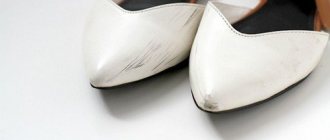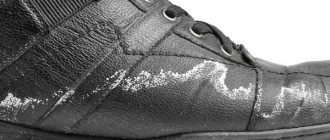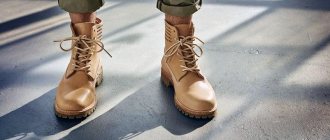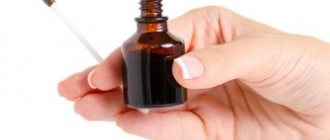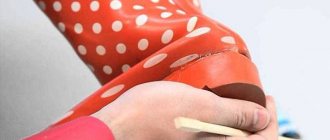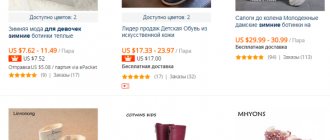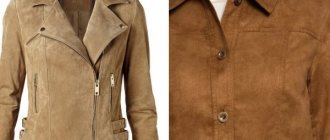The attractive appearance of a new pair of shoes is lost over time during use. One of the problems that arises is creases and folds.
This is not only an aesthetic defect, but also a factor that contributes to faster wear. There is a need to remove creases and restore the appearance of the pair.
We will tell you in this article how to remove creases from leather, suede, faux leather, and nubuck shoes.
Causes of the problem
The new shoes have a sleek upper and an attractive look. When walking, the leg in the foot constantly changes position, which leads to the appearance of bends on the surface. Even an expensive branded pair is not immune from this. But deep creases do not always occur.
The following factors contribute to this circumstance:
- low quality of the product (tailoring and materials);
- incorrectly selected size or model;
- violation of storage rules;
- wearing a pair in the wrong season for which it is intended;
- improper use and care.
The factor that contributes to the appearance of folds may be the model itself.
If a single piece of leather was used for manufacturing, then creases at the bend of the foot are more likely to appear than on shoes that were sewn from several small fragments, highlighting the toe. Another factor is incorrect selection of size and fullness. Creases appear more often in cases where:
- The last is too wide and the foot does not fit properly.
- The block, on the contrary, is too narrow, which leads to tension in the upper material that was not intended by the manufacturer.
Most often, creases form on shoes without heels, since in such a pair the foot bends more when walking.
Dry ironing
For smooth leather items, you can use dry ironing; a regular iron is suitable for this.
It is important to remember to turn off the steam generator. At average temperature conditions, on an inconspicuous part of clothing, you need to check how the skin reacts, whether it changes its color; if so, let it cool and make sure that the color is restored. In cases where the color of the item does not return, ironing is canceled. The smoothing process can only be carried out from the front side. The area of clothing is covered with natural fabric without relief; gauze is not suitable: although it is very thin, it leaves traces of its relief on the skin. We set the temperature to the lowest. Having laid out the leather clothes on the ironing board, carefully pick up and smooth out the wrinkled area. If the temperature regime is not sufficient to smooth out the wrinkles, gradually increase the temperature. After heat treatment, you need to let the skin cool without moving it, otherwise new folds will appear, then stroke the next fold.
For dry ironing of thick leather, use special thick wrapping paper. Plain paper is not suitable for such purposes. The iron only touches the paper; under no circumstances should you press it with force. You need to make sure that it does not come into contact with the thing. Given the risk, this method is recommended only for experienced ironers.
Dry ironing of leather is carried out without steam and through a dry cloth.
How to fix the defect?
If a defect appears on your favorite pair, you need to take action to fix the problem. It is advisable to start working at a stage before the creases become too strong and noticeable. It is easier to eliminate shallow folds than large creases.
Shallow
Homemade recipes will help you cope with a problem that has just arisen. They are not difficult.
Paper and cream
In order to remove only emerging wrinkles, you must perform the following steps:
- Stuff the toe of the pair tightly with crumpled paper, socks, or insert spacers to straighten the surface.
- Apply shoe polish, paying attention to problem areas.
- Leave the steam until the cream dries.
- Clean up.
- Remove the stuffing.
Wax and tinting
If the dents are small at the bend, you can use shoe wax. This product will soften and nourish the surface. Tinting is also suitable. But a good effect will only be achieved if the product is selected very accurately in color.
Cream
An emollient cream will help remove emerging creases.
Procedure:
- Lubricate the surface of the shoes with cream.
- Leave for a quarter of an hour.
- Stuff the sock tightly with paper.
- Place the pair on their side.
- Continue treatment 2 times a day for 3 days.
- After the bend has straightened, the remaining cream must be removed from the surface with a napkin.
- Apply shoe wax.
- Clean up.
- Remove the paper.
Deep
In cases where the problem has worsened and the fold has become pronounced, more complex methods of influence will have to be used.
You need to prepare the following tools in advance:
- iron;
- cloth napkin (preferably microfiber);
- water;
- paper for stuffing (or special pads).
Work order:
Stuff the toe of the shoe with paper.- Moisten the cloth with water and wring it out.
- Place the napkin on the area with the crease, pressing firmly against the skin.
- Leave for a few minutes until the surface of the skin becomes slightly moisturized.
- Turn on the iron and set the heat to medium.
- Gently iron the crease area with a cloth.
- Leave the steam to stand until completely dry.
- Remove paper.
- Apply cream or wax to the surface.
- Carry out high-quality cleaning.
The sole of the iron should not be allowed to come into direct contact with the surface of the shoe; treatment is only permissible through the intervening fabric.
The process of processing shoes with creases can be seen in the video:
How to remove creases?
The good news is that high-quality shoes can be restored to their original appearance with a number of simple manipulations. The exception is patent leather. In the latter case, even if it is possible to remove the damage, it can only be done by a specialist in reconstruction work of this type, who has a set of special tools and experience in such operations. It is almost impossible to restore leatherette of unknown composition.
Creases on shoes
Fighting creases on shoes made of genuine leather
Exposure to elevated temperatures in a humid environment is the most effective method. The first essential step in the entire process is to thoroughly clean the shoes. Each adhering piece of dirt or excess dust, during the crease leveling process, will leave stains on the surface of the shoe, reduce the elasticity of the area and make it impossible to get a perfect result.
How to even out leather on any shoes:
- The product is stuffed with suitable material: voluminous balls from crumpled newspapers, clean and dry rags, socks. They achieve a state where it seems that there is a wooden block inside the thing.
- A thick cloth, such as a towel, soaked in boiling water and then thoroughly wrung out, is placed over the area that needs to be resuscitated.
- Using an iron in medium heating mode, carefully pass over the fabric, ensuring that the steam from the towel is absorbed by the leather of the shoes being treated.
- To prevent shoe deformation, ironing is performed in short procedures until the desired effect appears.
- After heat treatment, the shoes are dried, rubbed with cream, then waxed and polished.
Creases on the skin
We eliminate creases on nubuck and suede without special equipment
The attractiveness of “velor” shoes is restored by influencing the creases with temperature and careful, targeted mechanical action. For the first, use a household hair dryer, for the second, a brush with rubber bristles or, in difficult cases, sandpaper with a fine dust of abrasive.
- The pair is thoroughly cleaned of dust, dirt and dried.
- The middle of each shoe or boot is filled with available filler, achieving ideal straightening of the leather.
- The emerging fold is ruffled as carefully as possible with a brush or sandpaper. With strong pressure, the treated area becomes bald and this defect cannot be eliminated.
- Cover the problem area with a slightly damp, clean rag, and then blow hot air over it.
- Thanks to the sauna effect, the pile straightens and suede or nubuck regains its attractive appearance.
- The shoes are dried, the filler is replaced with fresh filler and put in each time before sending the pair for storage.
What to do with leatherette?
Artificial leather is significantly different in structure from natural leather, despite its external similarity. You should not use recipes that are suitable for natural materials for dermantin and eco-leather, as they will not be effective.
The artificial material does not contain fibers that can expand when softened with waxes and oils. Therefore, shoes with non-natural uppers must be taken care of regularly and thoroughly.
If the rules of storage and wearing are violated, the creases quickly become deep and practically irremovable. Leatherette shoes should be stored with inserts or lasts , avoiding even slight deformation. It is also necessary to use special care products.
Basics of care
Genuine leather has features that should be taken into account when purchasing and wearing shoes. To prevent creases from forming on shoes and boots, you need to follow simple rules:
- You must always keep shoes made from natural materials clean and use them only for their intended purpose.
- Wet shoes need to be dried at room temperature. To prevent the product from deforming, you should stuff it tightly with paper.
- After drying, the skin must be treated with a special cream or wax to soften and moisturize it.
- You should not wear wet shoes, as the leather will stretch in this state.
- It is necessary to select a pair that matches your foot size.
- You can store boots, boots and shoes in cardboard boxes or textile bags, but not in plastic bags, which limit the access of oxygen.
Important! It is better not to use silicone-based shoe products, as they do not moisturize them, but only add shine and attract dust. It is not recommended to use heating devices or other heat sources for drying.
These simple recommendations will help prevent the appearance of creases and cracks in genuine leather products.
How to smooth suede and nubuck?
On suede and nubuck, folds may appear already in the first season of wearing shoes. But even on such complex material it is quite possible to eliminate defects.
To bring such a pair back to normal you will need:
- a special brush for suede with rubber bristles;
- damp cloth;
- hairdryer
Procedure:
Clean the surface from dirt and dust.- Insert the filler so that the outer surface of the shoe upper is smoothed.
- Carefully walk over suede (nubuck) with a special brush.
- Place a piece of damp cloth on top of the problem area.
- Turn on the hairdryer.
- Direct a stream of heated air onto the fold.
- Remove the rag.
- Let the shoes dry naturally.
Instead of a brush, you can use fine-grained sandpaper, but you need to use it even more carefully so as not to damage the pile.
Repairing cracks and scratches
Once the shoes are completely dry, you can move on to the next step—filling the cracks. Be sure to stuff crumpled up newspapers or rags inside your shoes first. This will help maintain their shape. Fill the shoes as much as possible so that there is practically no free space left. The newspaper will not only help maintain the shape of the boots, but will also absorb any moisture that may get inside.
You stick out your tongue: which selfies of yours he definitely won’t like
From drawing to meditation: how to improve relationships at home according to your zodiac sign
Delicate taste and health benefits: making avocado ice cream
Apply a moisturizer to your shoes, for example you can use mink oil. Pay special attention to the cracks, they need to be filled first. Do not skimp on the product, it should completely cover the creases. You can always remove any excess with a rag.
To help the product penetrate the cracks better, you can heat the shoes a little. Place it next to a heater or blow warm air with a hairdryer. This will help absorb the oil faster. Apply it not only to the cracks, but also to the entire surface of the shoe.
Why do I use mink oil? First of all, it is more convenient because it has a solid structure. It can be applied by hand. Moisturizers are made from wax and natural oils, so they are runny.
Prevention measures
In order to preserve the appearance of your shoes for as long as possible and avoid creases, you should adhere to the following preventive measures:
- If expensive dress shoes are intended to be worn only indoors, they should not be used outdoors.
- You should put on a pair using a shoe horn.
- Natural materials (leather, nubuck, suede) must be protected from frequent contact with water.
- You need to put on your shoes after first unfastening the clasp.
- It is recommended to have at least 2 pairs of shoes for the season, and wear them every other day, giving each pair the opportunity to dry and air out. Otherwise, due to constant moisture and incomplete drying, the pair will last less.
- Shoes should be cleaned after every use outside.
- Do not use soap or aggressive cleaning agents to care for natural leather.
- It is recommended to dry shoes in a room with good air exchange.
- Cream and wax should only be applied to dry and clean shoe surfaces.
- Do not wear shoes that are not completely dry.
- Shoes should be stored after having been stuffed with paper in conditions where deformation is excluded. The best option is right in the box.
- If your shoes get too wet, they can lead to deformation of the upper, creases, and even cracks.
Timely proper care of shoes will extend their service life and preserve their appearance for a long time.
Useful tips
When restoring shoes that have lost their original appearance, you should know some of the subtleties of the procedures themselves.
- So, wax is used only in metal jars. If it is offered in the form of an aerosol, then in this case this thing is absolutely useless.
- It is best to use kitchen paper towels as shoe filler.
- To speed up drying of shoes, you can use a hair dryer.
- Before you start treating the surface with “liquid leather”, you should test it on a small area.
Recommendations
Expert advice will help you cope with the task quickly and without problems:
Before removing creases, shoes must be cleaned of dust and dirt.- You should purchase shoes in accordance not only with the size, but also with the appropriate fullness.
- In cases where you can’t deal with creases on your own, or you don’t have time for this, you can turn to a shoe workshop for help.
- You should not use shoe care products immediately before going outside. This must be done in advance so that the cream has time to absorb and act.
- For removing creases, silicone-based products are less effective than wax-based products. This is due to the fact that silicone does not moisturize the surface, but only gives it shine.
- The purchased shoe care products must match the shoes not only in color, but also in the texture of the material. Information about this is present on the packaging. For example, “for smooth leather”, “for nubuck”, etc.
Causes of creases
Crinkles and folds on shoes made of natural materials in places of constant bending are formed even with proper care and careful use, and this is completely normal. On some models there are practically no defects or they are barely noticeable due to the correct selection of shoes in size. Creases appear on the skin when the product does not fit the shape and features of the foot, even if it is made of high-quality materials. It is impossible to guarantee the complete absence of defects on natural leather, but it is one thing when they are not visible, and another thing when there are many of them, they are large and located in different places. To avoid this, you need to choose boots and shoes that match the length, width and instep of your feet.
The folds on shoes that match the parameters of the foot are smooth, neat and barely noticeable. To know how to remove creases from leather shoes, you need to follow the recommendations for caring for them.
Another smoothed-out sneaker from Chantelle
Chantelle said that her life hack, which she learned a few years ago from a friend, was not liked by some.
“There is always a group of people in the world who have something negative to say, even when you show them something useful. I'm happy with people's reaction because my name started being heard a little more often and I was able to help a lot of people who didn't know about this life hack. It makes me happy,” she said.
Fatty, shiny spots
Removing stains from suede shoes is much more difficult. But there are chemicals and folk remedies that help effectively deal with unsightly salt stains.
Cleaning products
There are many ways to restore the attractive appearance of suede. You can remove salt stains from shoes at home using industrial chemicals and folk methods.
Specialized suede care products can remove salt stains from the material, while simultaneously preventing re-contamination the next time you go outside:
- Foam Combi Cleaner Salamander is a universal cleaner for leather, suede and textiles with lime oil, which can remove dirt, water stains, salt, and restore color. Apply using a napkin or sponge. After treatment with foam, the pile is treated with a special brush.
- Saphir Omni DAIM is a liquid with an enhanced formula for cleaning suede. Removes even old stains and stains, restores color. The pile is treated with a brush soaked in liquid, then with a sponge.
- DE SALTER Tarrago – removes stains and stains, neutralizes absorbed salt. The product is applied with a sponge attached to the bottle.
- Solemate Cleaner is a universal cleansing shoe shampoo. A small amount of the product is foamed with a sponge, then applied to the surface. After 5-7 minutes, remove excess with a damp cloth.
- NUBUCK CLEANER – spray for cleaning nubuck and suede. Nourishes, refreshes color, cleanses. Does not contain solvents.
Traditional methods
In the absence of special and quite expensive means to clean boots from stains, you can use folk recipes:
- Ammonia is diluted with water in a ratio of 1:5. Soak a sponge in the solution and clean the surface of the shoes in a circular motion. Then the surface is wiped with a solution of 1 tablespoon of vinegar in a liter of water. The solution will quickly remove fresh white stains.
- A soft brush is soaked in vinegar (9%) and white spots are removed. Then the surface is wiped with a damp cloth. Vinegar is also used to treat those places on suede shoes that begin to shine.
- 1 tablespoon of liquid soap is dissolved in 250 ml of water, 0.5 teaspoon of ammonia is added and the mixture is foamed. The resulting foam is applied with a sponge for several minutes. Residues of soap are cleaned with a damp sponge. Finally, the surface is cleaned with a brush soaked in vinegar.
- Light-colored models are cleaned with tooth powder. It is poured onto the surface, especially thickly on heavily polluted places, and left for an hour. The powder absorbs the salt and is then brushed off.
- Stains are wiped with dry crust of rye bread or raw potatoes. After cleaning, the surface is treated with a sponge.
- Special purified gasoline purchased at a hardware store. Moisten a cotton pad with gasoline and wipe off the stains. The treatment should be light and superficial, otherwise gasoline will dissolve the paint and stains will remain on the shoes.
- Fresh salt stains are evaporated over boiling water. Each boot is stuffed with newspapers and held over steam for 5-6 minutes, while simultaneously brushing off the soaking salt. When steaming, it is important not to overdo it. Processing for too long will lead to deformation of the shoes.
Suede shoes can suffer not only from winter reagents, but also from other types of pollution. Any dirt must be removed as quickly as possible, without waiting for it to dry. It will be much more difficult to deal with a well-absorbed, dried stain.
There are specific cleaning methods for each type of stain:
- Grass marks often appear on suede sneakers. Remove green grass from sneakers with a salt solution.
- Flower stains are removed with gasoline, then wiped with ammonia.
- The blood is washed off with a stream of water from the tap. Then the washed area is treated with a soap solution.
- Rust or other yellow spots are removed with a cotton pad soaked in lemon juice.
- Wax that accidentally gets on shoes is removed with a blunt object. Traces of wax are erased with gasoline.
- If chewing gum gets on the suede, place the shoes in a plastic bag and put them in the freezer. After a few hours, the chewing gum is cleaned off, and the traces of it are removed with gasoline.
- Wine stains are blotted with a napkin, then washed under running warm water.
- Shiny areas are treated with fine-grained sandpaper. Before treatment, the surface is slightly moistened with ammonia. Rub the shiny stain in one direction, with light pressure.
- Grease is effectively wiped off with pure gasoline. After treatment, sprinkle the greasy area with talcum powder, then clean it with a brush.
- After cleaning the stain, the pungent smell of gasoline is removed with a soap solution to which a few drops of ammonia are added.
We suggest you read How to clean suede gloves at home
Suede is an attractive and comfortable material to wear. Products made from it look elegant and luxurious. However, this material requires special care.
Suede seems to many people to be impractical and short-lived, as it requires careful care. If used incorrectly, the material becomes worn, shiny and loses its original appearance.
What is suede made from?
How to properly clean suede products
How to quickly remove a stain
Proper care of suede
Suede shoes have been especially popular in the last few seasons, which is why leading designers advise fashionistas to get them. If you follow the rules of cleaning, drying, and caring for suede shoes, you can maintain their attractiveness.
First of all, you need to determine what the material consists of. It should be noted that suede is divided into natural and artificial. All types of suede are used in the production of clothing, shoes and haberdashery goods.
Important
The natural material is made from animal skin, processed using a special technology - fat tanning. Its distinctive qualities are softness, velvety, viscousness and subtlety.
Almost in no way inferior to natural suede is artificial suede, which is made from modern materials.
The structure of the material has a fine pile, easily absorbs moisture, after which it swells and becomes rigid. Therefore, it needs careful and careful care.
However, in everyday life, various troubles arise (someone may step on, touch, or spill), after which contaminants are formed that are difficult to remove later.
Of course, in such a situation the question arises: how to clean suede products at home?
It should be immediately noted that this material does not tolerate moisture, so it is better to clean suede using dry products and methods.
If there are minor stains, you can try to remove them with a special eraser that is gentle on the suede surface. An alternative to a special eraser can be a simple rubber band.
If there are old or deep stains, the item can be dry cleaned.
Now there are several methods of dry cleaning, which are selected based on the materials used in the production of products (leather and suede, fur and suede, etc.). The most well-known method for removing complex stains is dry cleaning with perchlorethylene.
Advice
When using this toxic substance, you must follow safety rules and use special equipment. Sometimes cleaning can remove the water-repellent layer and paint, so it can be used in extreme situations. The most harmless type of dry cleaning is removing stains with hydrocarbon solvents.
The disadvantage of this method may be its low efficiency in dealing with heavily contaminated material.
For those who want to know about cleaning suede at home, some recommendations are given.
The optimal folk cleaning method is a mixture of soda and skim milk (a teaspoon of soda is added to a glass of milk). But this may leave white spots on the surface that can be painted over.
An effective means of removing dirt from a suede surface is a 10% ammonia solution, which can be replaced with soda (add ¼ cup of ammonia to ½ cup of milk).
Wipe the dirty area with a cloth moistened with liquid.
Light suede products are cleaned with white bread crumbs. To do this, rub the dried stain with a dry crust of bread, a rubber brush or fine sandpaper. There is no need to press or rub too hard. After treatment, comb the pile with a brush.
Heavily dirty light-colored items should be wiped with a napkin soaked in a solution of powder or soap with ammonia (20 grams of powder or soap flakes and a few drops of alcohol per 1 liter of water). After this, the surface must be washed with water and dried.
Please note that it is not advisable to get suede items too wet. Grease stains are removed with gasoline.
note
Suede gloves can be cleaned from dirt with simple toilet soap. Put them on your hands and treat the dirty areas with dry soap.
After this, you need to rinse the gloves with warm water and lay them out to dry, but not the battery.
If after drying they have become rough, you can give them softness and initial fluffiness using a vacuum cleaner or a clothes brush with hard bristles. White suede should be dried on a towel.
If shiny spots form, sprinkle them with starch, wait 30 minutes and clean with a dry fluffy brush. If after such treatment the contamination does not disappear, it is necessary to dilute the starch and ammonia, and then apply the resulting solution to the surface. After the treated area has dried, the starch can be removed with a fluffy brush.
During wear, suede products (especially folds) form creases. Lint jams may often occur. In this case, the item must be steamed using a simple iron or a bowl of hot water. The item must be held over steam, and then combed using a clothes brush with hard bristles.
The main thing is not to keep the products over steam for a long time, otherwise they can become very rough.
Contaminated ugg boots or shoes should be cleaned with a solution of soap and ammonia. Then you need to treat with a water-repellent spray. It can be bought at any store. Suede products can be cleaned with a brush, which must first be dipped in coffee grounds.
Vertical steaming
Ironing embossed, patent leather and laser-cut leather requires a gentler approach because they can easily become deformed and lose their aesthetic appearance.
In dry cleaning, in such cases, a steam generator is used. At home, you can use an iron with a vertical steam function.
Place the product in a vertical position. Turn on the steam function, spray the problematic part of the clothing with steam at a distance of up to 15 cm, without moving it until it cools completely. The thinner the material, the further the device is held. If the jacket has been treated with a special composition that protects against water, it will lose its shine. Then the procedure should be stopped and resort to folk remedies to solve the problem.
To steam a leather product, keep the iron at a distance from it.
Delicate smoothing with water
Leatherettes are sensitive to water and soften when wet. This property will help get rid of wrinkles on clothes.
Hang the damaged item on hangers with the inside out. Fasten the zipper and straighten it. The position of the sleeves should be familiar. Fill a container with a spray bottle with soft water at room temperature. Sprinkle the lining evenly until it is wet, but should not drip. Leave in this position for 12 hours and wait until the clothes dry completely.
Drying should take place naturally at room temperature, changes and drafts should be avoided. This technology is not for frequent use. You can do this only once a season. Thus, clothes made of eco-leather and dermantine can be stretched well.
Is it possible to iron artificial leather?
If there is no sign on the tag or label stating that contact with hot objects is prohibited, then the artificial leather can be ironed. In this case, it is necessary to strictly observe the following rules for ironing leatherette:
- It is recommended to conduct a small test. To do this, iron on the wrong side. If the area of leather is not deformed, then you can iron the entire product.
- When ironing, you need to make sure that the skin areas do not touch each other. For example, a fabric roller is inserted into the sleeve of a jacket.
- Iron the product, turning it inside out. If there is no lining, then you must use gauze or cotton fabric. Do not touch the iron directly!
- You need to turn off the steam function on the iron, observe the temperature regime - the temperature should not exceed 30 degrees. The steam from the iron should not come into contact with the skin. You need to use layers of gauze and keep the hot iron at a distance.
- After smoothing out all the irregularities, the product is immediately turned right side out and inspected for wrinkles. If there are wrinkled places, you can repeat the procedure.
- Immediately after smoothing, you need to hang the jacket on hangers and give it volume. To add volume, you can put a rolled towel in the sleeves. If the folds on the bag were removed with an iron, then a cushion or small pillow is placed in it.
When ironing a jacket, you should focus on the sleeves. It is quite difficult to iron them out.
To iron the sleeves well, you need to take a terry towel, fold it in half and insert it into the sleeves.
You can use the product after ironing within an hour.
This is what the prohibitory icon looks like on the product label. If it is present on the product, then ironing is strictly not recommended.
Steam treatment
Prepare an iron with a steam function or a steamer. Place faux leather clothes on hangers. Bring the device to the problem area at a distance of 10-15 cm and turn on the steam supply. The exposure time per place is several seconds. After steam treatment, leave the product alone for at least half an hour. The steamer will help you quickly straighten your collar, sleeves and small parts.
"Steam room"
Faux leather clothing can be straightened using steam in a tightly closed bathroom. Place the leatherette product on hangers and hang it high directly above the water, while avoiding contact with it. Open the hot water and run the bath until the room is filled with steam and the mirror becomes cloudy. Steam and strong humidity help smooth out minor bruises, and there is no need to resort to other methods. The procedure should last approximately 2 hours. During this time, you need to add hot water several times, turn the clothes and straighten out the folds.
When finished, move the item to a heated room and leave it to dry away from the radiator.
Promenade in the rain. Minor defects on a leatherette jacket can be eliminated by walking in rainy weather. To achieve the desired result, the raincoat or jacket must be completely wet and then dry naturally.
What to do with minor defects?
Leather is a flexible and soft material, so there should not be any particular difficulties in leveling it. Defects in the form of creases usually appear due to roughness of the skin, so the first task is to soften the shoes, eliminating aesthetic defects.
You can remove minor folds and creases from leather shoes using one of the following solutions:
- For minor creases, fill the shoes with paper and lubricate them with shoe polish. For light leather shoes, you can use milk.
- Generously coat the creases with emollient cream and leave for 15 minutes. After this, fill the shoes with newspapers, paper or insert wooden blocks and lay them on their sides, leaving them alone for a couple of days, renewing the cream layer in the morning and evening. After two days, clean the shoes from any remaining cream, rub them with wax and remove the paper.
This is interesting! Instead of cream, you can use glycerin or castor oil, their effectiveness is no worse.
- Wax your shoes or paint them thoroughly.
Important! When choosing a paint, you need to familiarize yourself in detail with its instructions and composition, and choose a good and well-known manufacturer.
Why do creases appear on shoes?
To begin with, we suggest understanding the causes of such defects. When we see a pair in the store, especially the suede one, it looks perfect. And we want it to remain that way. But this is impossible. During walking, the position of the foot changes. The shoes, in turn, follow the movements of the foot, which is why creases appear in the toe area.
On a note! More severe creases remain on shoes with flat soles.
If you wear your boots or shoes carefully, natural creases remain almost invisible. But if you treat your shoes incorrectly, do not clean them in a timely manner and store them carelessly, you risk leaving significant defects on them, which will then be difficult to get rid of.
